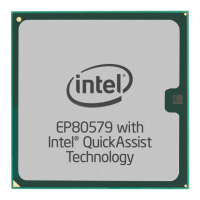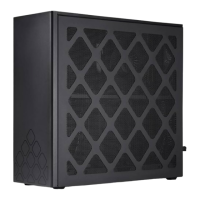Intel
®
EP80579 Integrated Processor Product Line May 2010
Order Number: 320068-005US 49
High-Speed Design Concerns—Intel
®
EP80579 Integrated Processor Product Line
5.5.1 Brief EMI Theory
Electromagnetic energy transfer may be viewed in four ways:
• Radiated emissions
• Radiated susceptibility
• Conducted emissions
• Conducted susceptibility
For system designers, reduction of radiated and conducted emissions is the way to
achieve EMC compliance. Susceptibility is typically not a major concern in the server
environment, although it may be more important in an industrial environment.
The main component of EMI is a radiated electromagnetic wave, which consists of both
electric (E-fields) and magnetic (H-fields) waves traveling together and oriented
perpendicular to one another. Although E- and H-fields are intimately tied together,
they are generated by different sources. E-fields are created by voltage potentials,
while H-fields are created by current flow. In a steady state environment where voltage
or current is unchanging, E- and H-fields are also static and of no concern to EMI.
Changing voltages and currents are of concern since they contribute to EMI. When a
dynamic E-field is present, there must be a corresponding dynamic H-field and vice
versa. Motherboards with fast processors generate high-frequency E- and H-fields from
currents and voltages present in the component silicon and signal traces.
Two methods exist for minimizing E- and H-field system emissions: prevention and
containment. Prevention is achieved by implementing design techniques that minimize
the ability of the motherboard to generate EMI fields. Containment is used in a chassis
environment to contain radiated energy within the chassis. Careful consideration of
board layout, trace routing, and grounding may significantly reduce a motherboard’s
radiated emissions and make the chassis design easier.
5.5.2 EMI Regulations and Certifications
Original Equipment Manufacturers (OEMs) ensure EMC compliance by meeting EMI
regulatory requirements. System designers must ensure that their computer systems
do not exceed the emission limit standards set by applicable regulatory agencies.
Regulatory requirements referenced in this document include:
• United States Federal Communication Commission (FCC) Part 15 Class B.
• International Electrotechnical Commission's International Special Committee on
Radio Interference (CISPR) Publication 22 Class B limits.
The FCC rules require any OEM that sells an “off-the-shelf” motherboard in the United
States to pass an open chassis test. Open chassis testing is defined as removing the
chassis cover (or top and two sides) and testing for EMI compliance. This test must be
completed even though the permitted emission levels on the open chassis are allowed
to be higher. Removing the cover greatly reduces the shielding provided by the chassis
and increases the amount of EMI radiation. The purpose of this regulation is to ensure
that system boards have reasonable emission levels since they are one of the main
contributors to EMI.
5.5.3 EMI Test Capabilities
FCC regulations in the United States specify the maximum test frequency for products
with clocks in excess of 1 GHz is five times the highest clock frequency or 40 GHz,
whichever is lower. OEMs are advised to inquire into the capabilities of their preferred
EMC test lab to ensure they are able to scan up to the required frequency range.

